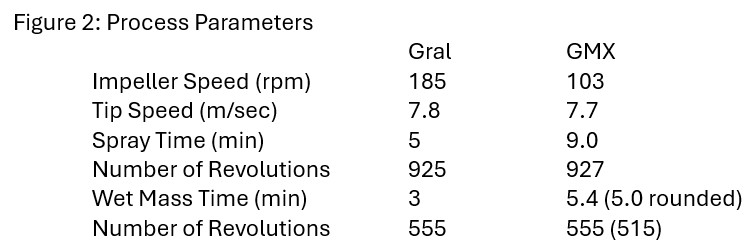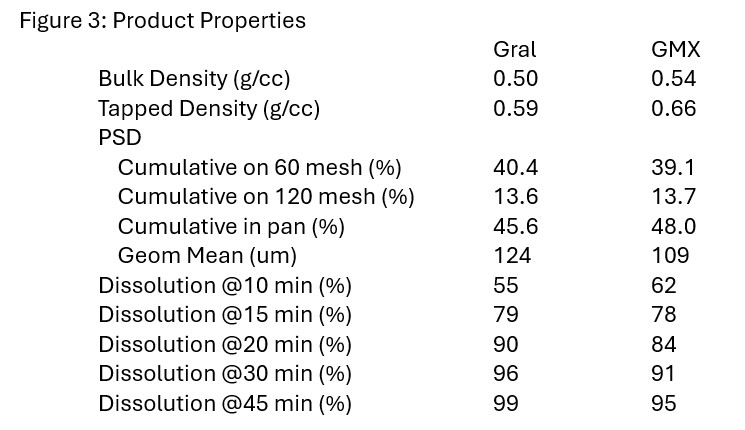Manufacturing and Analytical Characterization - Chemical
(T1330-10-59) High Shear Wet Granulation Scale-Up Using Basic Principles
Tuesday, October 22, 2024
1:30 PM - 2:30 PM MT

Gus B. LaBella, BS
Director Formulation Development
Mikart
Atlanta, Georgia, United States
Gus B. LaBella, BS
Director Formulation Development
Mikart
Atlanta, Georgia, United States
Presenting Author(s)
Main Author(s)
Purpose: To evaluate the scale-up of a high shear wet granulation process by maintaining impeller speed and the same number of impeller revolutions.
Methods: The formulation utilized is shown in Figure 1. A development scale batch was prepared using a Collette Gral 300. A process was developed using an impeller speed of 185 RPM with a 5-minute spray time for binder solution and a 3-minute wet massing time. In the Gral 300 running at 185 rpm, the impeller will make 925 revolutions in 5 minutes. The batch was scaled up using a Freund GMX-1200 high shear granulator. Batch sizes were 132 kg (granulated in two sublots) and 352 kg (granulated in two sublots). An equivalent tip speed was calculated for the GMX-1200, and the impeller speed was set to 103 rpm. At this impeller speed, to make 925 revolutions takes 9 minutes. The lower RPM (equivalent tip speed) requires a longer time to complete the same number of revolutions in the GMX-1200 granulator. Process parameters are shown in Figure 2., Figure 1: Formulation Figure 2: Process Parameters: After granulating and fluid bed drying two sublots of granulation, dry additions were blended into the product. Tablets were compressed at target hardness on a rotary press and an aesthetic film coating was applied to the tablets. Dissolution profiles were tested for each batch and an f2 comparison was performed. Bulk and tapped density, particle size and dissolution were evaluated to assess the product at the two scales.
Results: Figure 3 shows the results from each batch manufactured. Figure 3: Product Properties: One difference between the two scales was the loading in the granulator due to the desired commercial batch size. In the Gral 300, the loading was 57% but in the GMX-1200, it was reduced to 38%.
Conclusion: The techniques utilized produced a similar granulation after scale-up with similar dissolution (f2 = 65). The larger scale batch did produce a slightly smaller particle size with slightly less coarse particles and slightly more fines. This difference in particle size may also contribute to the higher density values also seen. One other technique utilized for scale up is to utilize similar tip speed while maintaining the granulating times from the smaller scale. Should this method had been chosen, the granulation would likely have produced an even smaller particle size. While minor differences are noted, it is felt that this technique is an effective method to scale-up the high shear wet granulation process.



Methods: The formulation utilized is shown in Figure 1. A development scale batch was prepared using a Collette Gral 300. A process was developed using an impeller speed of 185 RPM with a 5-minute spray time for binder solution and a 3-minute wet massing time. In the Gral 300 running at 185 rpm, the impeller will make 925 revolutions in 5 minutes. The batch was scaled up using a Freund GMX-1200 high shear granulator. Batch sizes were 132 kg (granulated in two sublots) and 352 kg (granulated in two sublots). An equivalent tip speed was calculated for the GMX-1200, and the impeller speed was set to 103 rpm. At this impeller speed, to make 925 revolutions takes 9 minutes. The lower RPM (equivalent tip speed) requires a longer time to complete the same number of revolutions in the GMX-1200 granulator. Process parameters are shown in Figure 2., Figure 1: Formulation Figure 2: Process Parameters: After granulating and fluid bed drying two sublots of granulation, dry additions were blended into the product. Tablets were compressed at target hardness on a rotary press and an aesthetic film coating was applied to the tablets. Dissolution profiles were tested for each batch and an f2 comparison was performed. Bulk and tapped density, particle size and dissolution were evaluated to assess the product at the two scales.
Results: Figure 3 shows the results from each batch manufactured. Figure 3: Product Properties: One difference between the two scales was the loading in the granulator due to the desired commercial batch size. In the Gral 300, the loading was 57% but in the GMX-1200, it was reduced to 38%.
Conclusion: The techniques utilized produced a similar granulation after scale-up with similar dissolution (f2 = 65). The larger scale batch did produce a slightly smaller particle size with slightly less coarse particles and slightly more fines. This difference in particle size may also contribute to the higher density values also seen. One other technique utilized for scale up is to utilize similar tip speed while maintaining the granulating times from the smaller scale. Should this method had been chosen, the granulation would likely have produced an even smaller particle size. While minor differences are noted, it is felt that this technique is an effective method to scale-up the high shear wet granulation process.



